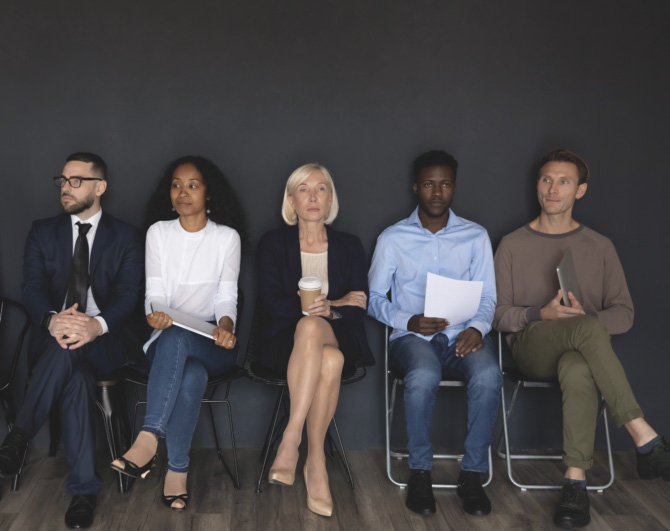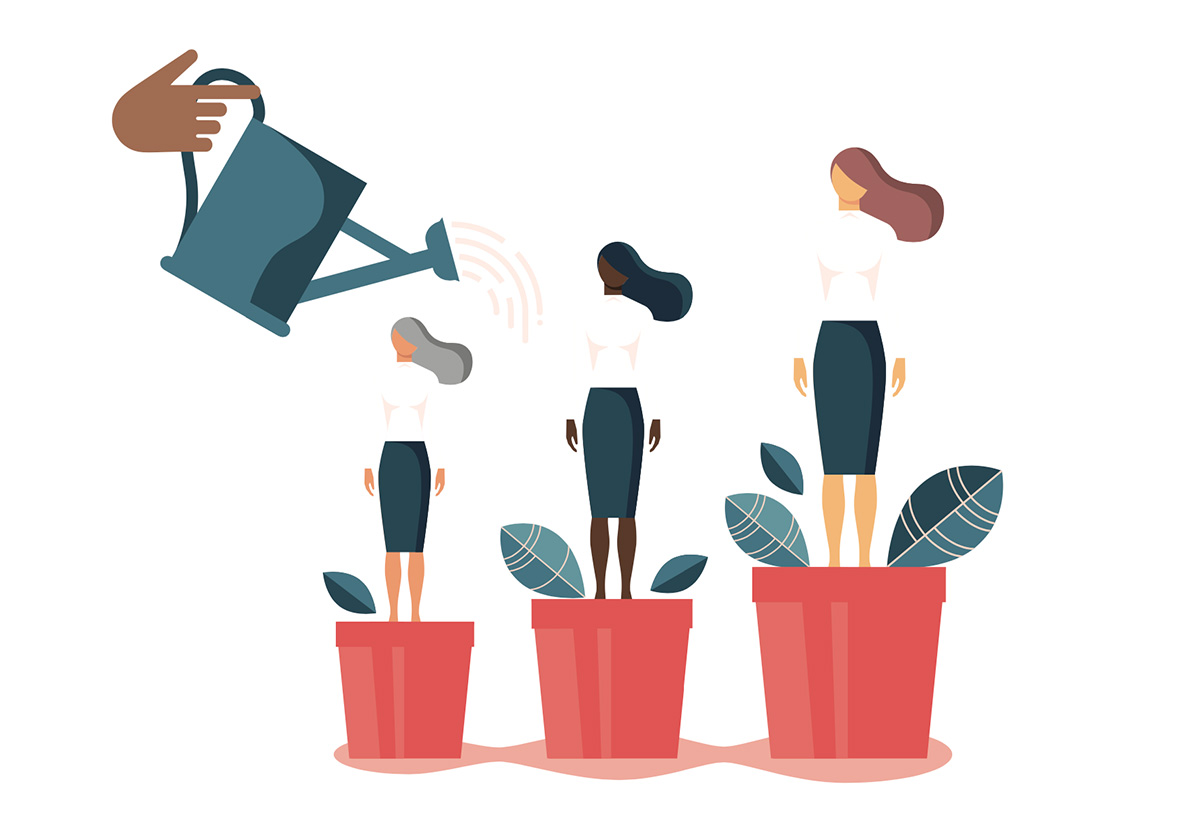Creating diverse and inclusive organizations is a bigger imperative than ever. Leaders need to pick up the pace.
Our consciousness of systemic racism and inequity is heightened. The wave of protests and social unrest that followed the deaths of George Floyd, Breonna Taylor and Ahmaud Arbery have combined with the disproportionate effects of Covid-19. The economic impact of the virus on women and minorities has brought diversity and inclusion concerns into sharper focus – both in society as a whole and within organizations, in the US and in many other parts of the world.

A pervasive lack of diversity, equity and inclusion (DEI) is not a new problem. Yet data shows overall change and progress have been painfully slow. Change in business more broadly is not new to the 2020s – we’ve been dealing with it for as long as commerce has existed. But the velocity and scope of change today is very different. The continued exponential increase in computing power, coupled with an explosion of new technologies and accelerated globalization, are creating extraordinary possibilities and simultaneously upending industry norms and business models. Industry incumbents must now learn to adapt to a business environment of exponential, not linear, change.
In this new exponential era, the disruptions come thick and fast with the most disruptive forces emanating from non-traditional competitors. If industry leaders were still governing the rate of change, we’d be talking about oil and gas, not energy; curative not preventive healthcare; and still renting our movies from Blockbuster. As Netflix chief executive Reed Hastings has said, “Companies rarely die from moving too fast, and they frequently die from moving too slowly.” For companies to survive, they need to be able to adapt faster by synchronizing the rate of change inside to match the rate of change in the market.
If the pace of change around diversity and inclusion is left to incumbent leaders, it will remain slow and steady – at best. What’s acceptable in our organizations has been disrupted, thanks to our collective heightened consciousness of the remnants of systemic racism and the lack of inclusion at work, and a younger generation bringing new expectations and standards into the workplace.
Recent events should serve as an inflection point, permanently changing the slope of the change curve around diversity and inclusion. Accelerating progress in our organizations requires us to simultaneously disrupt what’s acceptable and enable different outcomes at an organizational, team, and individual level.
A global challenge
The diversity and inclusion challenge is global in nature – although it has particular resonance in the US. Jennifer Richeson, a social psychologist at Yale, points out that since the founding of the US the prevailing cultural sensibility has been optimistic, future-oriented, sure of itself and convinced of America’s inherent goodness. Despite our tragic racial history, Americans generally believe that the country has made and continues to make steady progress toward racial equality. However, this often rings hollow, particularly when it comes to racial gaps in education, health, criminal justice and personal wealth.
Yet the protests of 2020 were not limited to the US: they were witnessed across the world. Global stars of film, music and sports reinforced the message. National contexts differ – but the demand for greater inclusion in the workplace is heard loudly around the world. We need to accelerate real change.
The organizational level
McKinsey research shows companies in the top quartile for both gender and ethnic diversity are 12% more likely to financially outperform other companies. In sector after sector, there is a clear evidence base for the benefits of diversity – even film and TV. A recent McKinsey report on the Hollywood ecosystem estimated that the $148 billion film and TV industry is leaving more than $10 billion in annual revenue on the table by not resolving its inequity issues when it comes to black inclusion (‘Black representation in film and TV’, McKinsey.com, March 2021). Its dismal record sets Hollywood behind even traditionally male-dominated industries like oil and gas.
The data on the benefits of improved DEI is compelling – but behavioral science shows that it takes much more than compelling information to persuade people to make what they perceive to be difficult changes. At the organizational level, boards and executive committees have to set real targets and create consequences.
Janet Stovall, senior strategist at the NeuroLeadership Institute, developed her thinking on this at Davidson College in North Carolina in 1984. This small college had only 52 black students among 1,200; one black professor and one black assistant dean. She created Project ’87, challenging the school to enroll 100 black students, hire 10 black professors, create five black studies classes and hire one black dean by 1987. As Stovall says, this meant that the school had to get serious about diversity. It created a mechanism for measuring its commitment. The changes took a little longer than planned, but they did happen.
Stovall advocates that businesses should borrow three things from Project ’87: real problems, real numbers and real consequences. She makes a useful distinction. Diversity is a numbers game so companies can mandate diversity – but they have to cultivate inclusion. And if inclusion is the bigger goal, then companies should be setting diversity goals around 30% (or higher), because that’s the point at which research shows that the voices of minority groups begin to be heard.
At Duke CE’s recent ‘Lead with Her’ event, Ann Cairns, executive vice chair at Mastercard, highlighted the importance of knowing the numbers when it came to increasing the number of women in board roles in the UK over the past decade. In 2010, just 12.5% of FTSE 100 companies’ board members were women in 2010: “It is now more than 36%,” points out Cairns. Progress was achieved “by setting aspirational goals.” There is still a distance to go, she said, but there are reasons for optimism: “Ninety-five percent of the world’s biggest companies are run by men – that’s not wonderful. The fact that is wonderful is that these men are standing up and saying, ‘We want to change’.”
The individual level
A good deal of the foundational work that has to be done at an individual level involves making people aware of, and able to manage, their own biases. Patricia Devine, professor at the University of Wisconsin (interviewed in Dialogue Q1 2021) leads workshops on techniques for breaking the “prejudice habit.” She describes this phenomenon as “unintentional bias,” arguing that “the important component of these automatic processes is that they are often unintended.” Indeed, “They are often at odds with and in conflict with what people intend to do and there is no need to treat their having bias as a moral indictment of their character.” When people become aware of their biases they can see the conflict with their intentions; given guidance on how to address those biases, they typically act.
Devine frames unintentional bias as a “habit of the mind” – it is automatic, “just like biting your nails or cracking your knuckles.” We have to learn to detect, reflect, and reject these habits. Mental habits can be harder to break than physical ones because they are often harder to detect, yet it is very doable. We need to learn to slow down and “detect” more, as Devine puts it – and learn how to regulate the expression of bias using specific strategies.
Achieving this change in behavior requires that people are engaged as active participants in their own change processes. That is where experiences like the diversity and inclusion workshops developed by Kim Taylor-Thompson, NYU clinical law professor and former chief executive of Duke CE, and Daisy Lovelace, professor at Duke’s Fuqua School of Business, are having a real impact. Their workshops have been run in a number of large organizations and shown good results in moving people from awareness to action. As Lovelace points out, “the workshops are effective because they offer participants an opportunity to reflect on their personal experiences within a broader socio-political and historical context. Recognizing your own unconscious bias is a good first step that should be followed by intentional efforts to become more consciously inclusive.” As such, participants are given opportunities to examine their role in producing an inclusive environment in their own sphere of influence – “specifically the things they say and do.” The workshops are immersive and experiential, addressing the issues from varied perspectives. Coupled with structured and supported application, such workshops can lead to active experimentation and real change.
The team level
Teams are quickly becoming the most pervasive and arguably the most important work unit in organizations. Deloitte’s Global Human Capital Trends survey (2017) found that 88% of respondents were prioritizing building the organization of the future, reorganizing into flatter, more networked team structures. Teams are where strategies are implemented, innovations emerge and change happens. They are where company culture meets real work and shapes employees’ everyday experience. As such, there is an opportunity – and an important need – to ensure that team leaders know both how to change their own mental habits, and how to build inclusive environments. As Oris Stuart, chief people and diversity officer of the NBA says in Dialogue’s Big Interview, we all have a “diversity reflex” – but “we need to focus on building an inclusion instinct.”
This squares with the findings of Google’s two-year Project Aristotle study, which found that one of the main things that distinguished high-performing teams was their ability to create a psychologically safe environment. As Harvard’s Amy Edmondson says: “I’ve spent over 20 years studying workplaces in healthcare delivery, high tech, the drug industry, consumer products, and the one consistent finding from this research is that psychological safety plays a central role in their success.”
A psychologically safe environment is one in which people feel comfortable bringing their whole self to work and believe that they can speak up candidly with ideas, questions, concerns, and even mistakes. The team level is key. Team members understand how to ensure that all voices are heard, manage conversational dynamics productively, and demonstrate both vulnerability and empathy. It is about creating a team-wide level of self-awareness and managing the collective human factors, to bring out the best in each of us and in the team as a whole. This capacity is particularly important at a time when organizations confront such uncertainty and so many ‘unknowns.’
At a recent event with the leadership team of a private equity firm, the leaders initially struggled to join up the need to build an inclusive, psychologically safe environment with their desire to create the conditions for free debate. As the session progressed, it emerged that when leaders challenged new ideas or suggestions, it tended to result in the more junior members shutting down. The effect was particularly strong among the women in the company, who often complained about this being part of a “boys’ club effect.”
On hearing this feedback, the firm’s leaders realized that they were inadvertently creating the opposite dynamic to what they wanted. One of the senior partners said, “I know that my impatience for good results hasn’t always fostered the kind of environment we need collectively. I’m still learning. I also know that we need everyone’s voice in our growth strategy conversation. What are we missing in our strategy from your perspective that might get in the way of the success we all want?” Coupling vulnerability with open-ended questions shifted the dynamic and brought about better decision-making. Realizing that the absence of inclusion was undermining the open, robust debate that they needed, the company’s leaders immediately set about changing the environment.
One of the fastest ways to change things within organizations is to ensure diversity – but it is only part of the picture. While diversity is a numbers game, inclusion needs to be cultivated. Building an inclusive instinct takes lots of listening, practice and energy. To cultivate inclusive environments that drive better results, we need to help leaders learn how to disrupt their own mental habits and enable them to build this inclusive instinct. It’s not easy, but it’s worth it. If we stay at the current pace of change, we will never have equitable workplaces. Let’s lean in and pick up the pace.
Michael Canning is global managing director of innovation and new commercial models at Duke Corporate Education and editorial chair of Dialogue. Vishal Patel is global managing director, Americas and Asia, at Duke CE.



